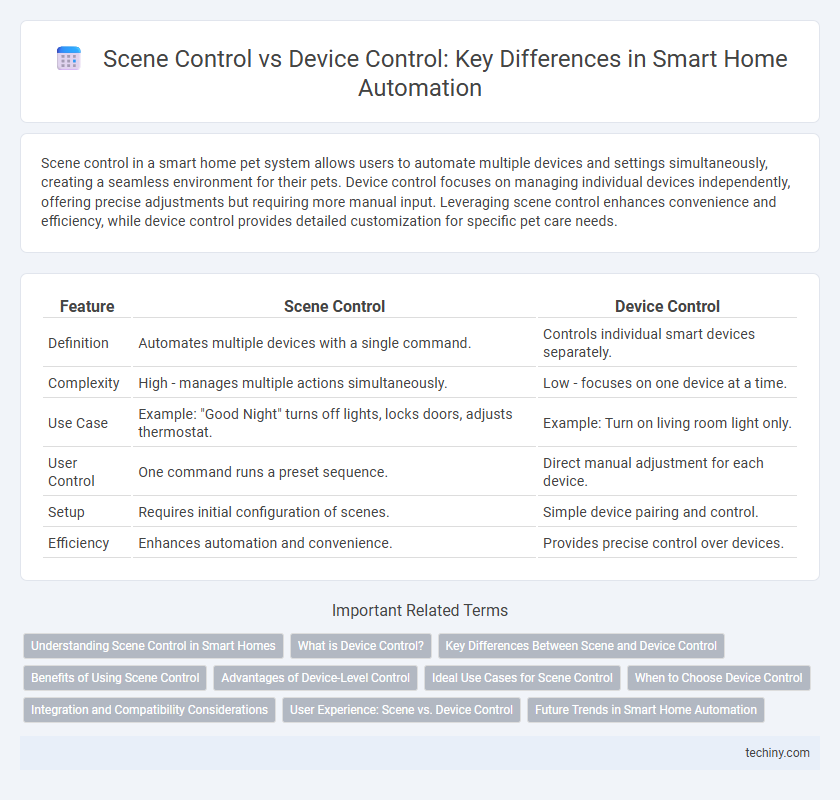Scene control in a smart home pet system allows users to automate multiple devices and settings simultaneously, creating a seamless environment for their pets. Device control focuses on managing individual devices independently, offering precise adjustments but requiring more manual input. Leveraging scene control enhances convenience and efficiency, while device control provides detailed customization for specific pet care needs.
Table of Comparison
| Feature | Scene Control | Device Control |
|---|---|---|
| Definition | Automates multiple devices with a single command. | Controls individual smart devices separately. |
| Complexity | High - manages multiple actions simultaneously. | Low - focuses on one device at a time. |
| Use Case | Example: "Good Night" turns off lights, locks doors, adjusts thermostat. | Example: Turn on living room light only. |
| User Control | One command runs a preset sequence. | Direct manual adjustment for each device. |
| Setup | Requires initial configuration of scenes. | Simple device pairing and control. |
| Efficiency | Enhances automation and convenience. | Provides precise control over devices. |
Understanding Scene Control in Smart Homes
Scene control in smart homes enables users to manage multiple devices simultaneously by activating preset scenarios tailored to specific activities or moods, such as "movie night" or "away mode." Unlike individual device control, scene control simplifies complexity by automating coordinated responses, improving energy efficiency and user convenience. Advanced scene control systems integrate with AI to adapt settings dynamically based on user behavior and environmental factors.
What is Device Control?
Device control in a smart home refers to the ability to manage individual smart devices such as lights, thermostats, cameras, and locks through dedicated apps or voice commands. It allows precise adjustments and direct interaction with each device's specific functions, enabling users to turn devices on or off, set temperatures, or monitor security status. This granular level of control contrasts with scene control, which activates multiple devices simultaneously based on predefined configurations.
Key Differences Between Scene and Device Control
Scene control enables users to automate multiple devices simultaneously based on specific scenarios, enhancing convenience and energy efficiency. Device control targets individual smart devices, providing granular command over functionalities like lighting, temperature, or security. The key difference lies in scene control's ability to integrate diverse devices into cohesive actions versus device control's focus on isolated management.
Benefits of Using Scene Control
Scene control in smart homes enables users to manage multiple devices simultaneously through a single command, enhancing convenience and efficiency. This approach reduces the need for individual device adjustments, creating seamless automation tailored to specific activities or moods. Implementing scene control optimizes energy usage and improves user experience by synchronizing lighting, temperature, and entertainment systems cohesively.
Advantages of Device-Level Control
Device-level control in smart homes offers precise management by allowing users to operate individual devices independently, enhancing customization and flexibility. This granular control optimizes energy efficiency and reduces unnecessary power consumption by activating only specific appliances as needed. Moreover, it enables faster response times and personalized automation, improving overall user experience compared to broader scene control methods.
Ideal Use Cases for Scene Control
Scene control in smart homes excels in managing multiple devices simultaneously to create a unified environment, such as activating lighting, adjusting thermostats, and closing blinds for movie time. Ideal use cases include morning routines where lights, coffee makers, and window shades operate in sync, enhancing convenience and energy efficiency. This holistic approach simplifies complex interactions, delivering seamless user experiences that device-by-device control cannot match.
When to Choose Device Control
Device control is ideal when precise management of individual smart home gadgets is required, such as adjusting a specific light's brightness or changing the thermostat setting in one room. This approach ensures direct and immediate responses to user commands without triggering multiple devices simultaneously. Choose device control when customization and fine-tuning of single smart devices matter most in your home automation setup.
Integration and Compatibility Considerations
Scene control in smart home systems integrates multiple devices into a unified automation sequence, enhancing user convenience by triggering coordinated actions through a single command. Device control focuses on managing individual appliances, offering granular customization but often requiring separate apps or interfaces, which may limit seamless operation. Compatibility considerations are critical, as effective scene control demands interoperable protocols like Zigbee, Z-Wave, or Matter to ensure diverse devices from various manufacturers communicate smoothly within the ecosystem.
User Experience: Scene vs. Device Control
Scene control enhances user experience by allowing multiple devices to be managed simultaneously through a single command, creating cohesive environments such as "Movie Night" or "Away Mode." Device control provides granular management of individual gadgets, offering precision but requiring more user input and time. Prioritizing scene control improves convenience and efficiency, making smart homes more intuitive and responsive to user needs.
Future Trends in Smart Home Automation
Scene control in smart home automation centralizes multiple device functions into a single command, enhancing user convenience and energy efficiency, while device control allows granular management of individual smart appliances. Future trends indicate increasing adoption of AI-driven scene control systems that learn user preferences and optimize settings autonomously across lighting, climate, security, and entertainment devices. Integration of voice assistants and IoT ecosystems will further advance predictive scene-based automation, creating seamless and context-aware smart home environments.
Scene Control vs Device Control Infographic

 techiny.com
techiny.com